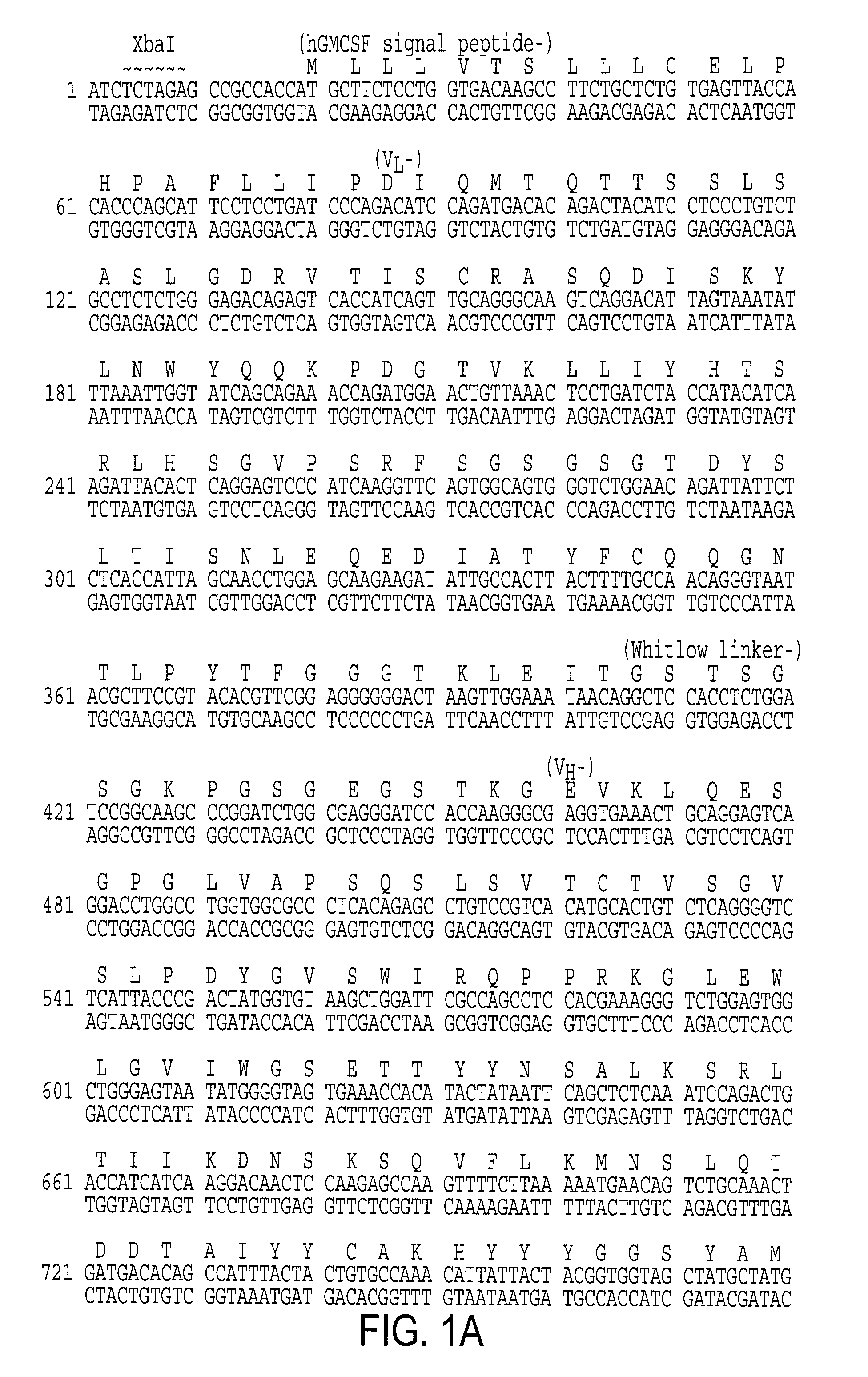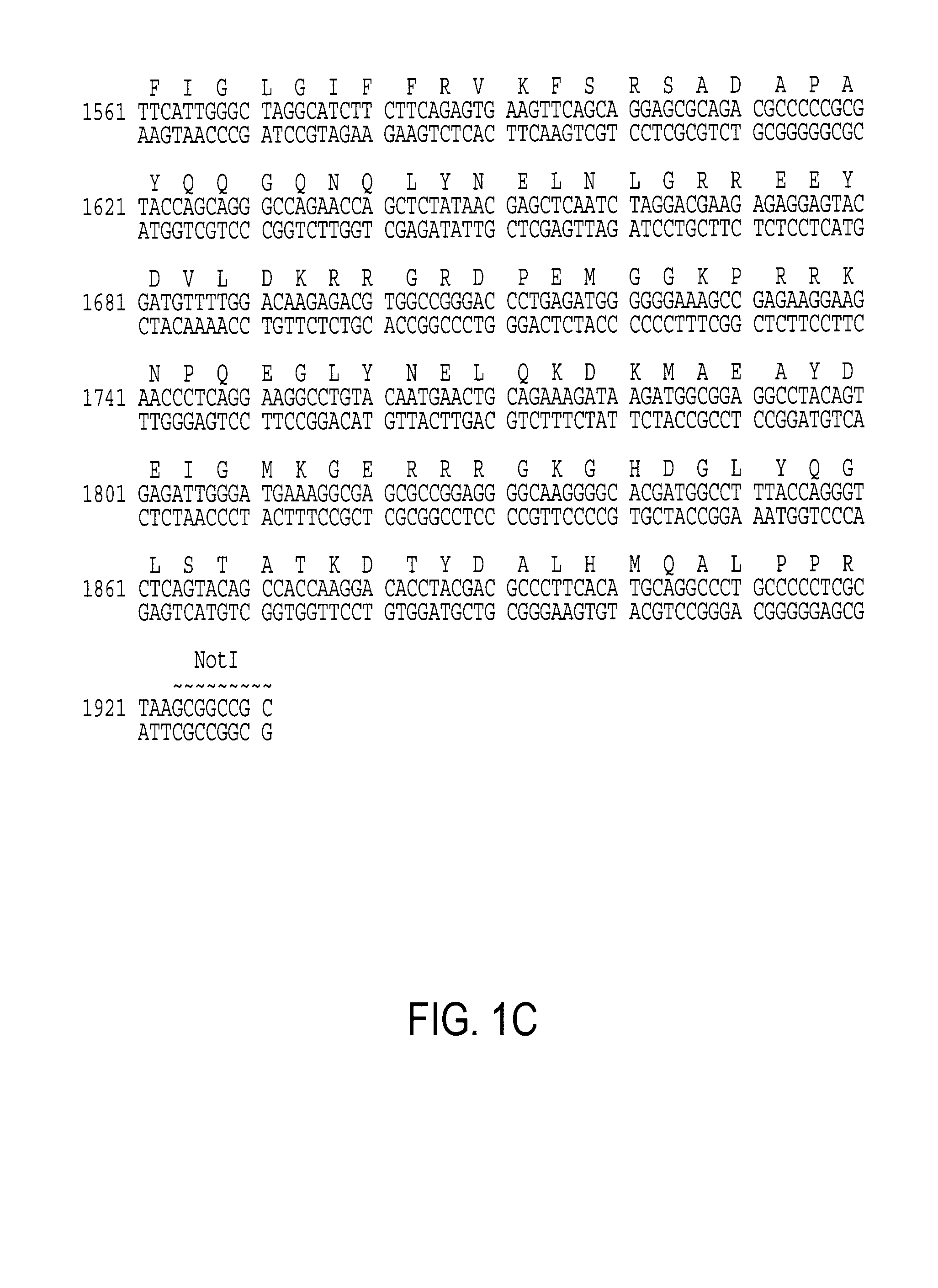CD19-specific chimeric T cell receptor
a chimeric t cell receptor and cd19 technology, applied in the field of redirected immune cells, can solve the problems of poor prognosis of patients with bcr-abl positive acute lymphoblastic leukemia (all) treated with chemotherapy, obstacles to successful hsc transplantation, and inability to maximally intensive preparative regimens combined with immunologic grafts
- Summary
- Abstract
- Description
- Claims
- Application Information
AI Technical Summary
Benefits of technology
Problems solved by technology
Method used
Image
Examples
example 1
Construction of a scFvFc:ζ cDNA Incorporating the FMC63 VH and VL Sequences
[0065]Based on the VH and VL sequences of the CD19-specific murine IgG1 monoclonal antibody published by Nicholson et al., a scFv sequence was constructed de novo utilizing PCR [83]. A full length scFvFc:ζ cDNA designated CD19R:zeta was constructed by PCR splice overlap extension and consists of the human GM-CSF receptor alpha chain leader peptide, FMC63 VH, Gly-Ser linker, FMC63 VL, human IgG1 Fc, human CD4 TM, and human cytoplasmic zeta chain. The nucleotide sequence of the construct and the resulting amino acid sequence are set forth in together in FIGS. 1A-C or separately as SEQ ID Nos:1 and 2, respectively.
[0066]The CD19-specific scFvFc:ζ receptor protein is expressed in Primary Human T cells. To determine whether the CD19-specific scFvFc:ζ construct could be expressed as an intact chimeric protein, T cells were transfected with the plasmid of Example 1 containing the CD19R. Linearized plasmid was electr...
example 2
CD19-Specific Re-Directed Effector Functions of T Cells Expressing the FMC63 Chimeric Immunoreceptor
2(A)-Cytokine Production by Chimeric T-Cells:
[0067]Referring now to FIG. 4, the function of the CD19R:zeta chimeric immunoreceptor in T cells was first assessed by expressing this scFvFc:ζ construct in primary human T cell clones. Clones secrete cytokines (IFN-γ, TNF-α, and gm-CSF) specifically upon co-culture with human CD19+ leukemia and lymphoma cells. Using techniques well known in the art and further described herein, chimeric T-cell clones were isolated which expressed the CD19R:zeta chimeric immunoreceptor. FIG. 4 shows the results of incubation of various T-cell clones expressing the recombinant CD19:zeta chimeric immunoreceptor with CD-19 leukemmia cell lines. 1873-CRL is a human CD19+ / CD20− ALL cell line purchased from ATCC. DHL-4 is a human CD19+ / CD20+ lymphoma cell line. Iona=lonomycin purchased from Sigma. This chemical is a calcium ionaphore. PMA=Phorbal-12-myristate-13 ...
example 3
Generation and Characterization of T Cell Clones for Therapeutic Use
[0071]All T cells administered are TCR α / β+ CD4−CD8+ scFvFc:ζ+T cell clones containing unrearranged chromosomally integrated plasmid DNA. T cells are isolated from the peripheral blood of the transplant recipient's HLA-matched marrow donor. Materials and methods employed to isolate, genetically modify, and expand CD8+ T cell clones from healthy marrow donors are detailed in Examples 4-8. T cell clones genetically modified to express the CD19R:zeta scFvFc:ζ chimeric immunoreceptor and HyTK are selected for:[0072]a. TCRα / β+, CD4−, CD8+ surface phenotype as determined by flow cytometry.[0073]b. Presence of a single copy of chromosomally integrated plasmid vector DNA as evidenced by Southern blot.[0074]c. Expression of the scFvFc:ζ gene product as detected by Western blot.[0075]d. Specific lysis of human CD19+ cell lines in 4-hr chromium release assays.[0076]e. Dependence on exogenous IL-2 for in vitro growth.[0077]f. M...
PUM
| Property | Measurement | Unit |
|---|---|---|
| median time | aaaaa | aaaaa |
| concentration | aaaaa | aaaaa |
| volume | aaaaa | aaaaa |
Abstract
Description
Claims
Application Information
 Login to View More
Login to View More - R&D
- Intellectual Property
- Life Sciences
- Materials
- Tech Scout
- Unparalleled Data Quality
- Higher Quality Content
- 60% Fewer Hallucinations
Browse by: Latest US Patents, China's latest patents, Technical Efficacy Thesaurus, Application Domain, Technology Topic, Popular Technical Reports.
© 2025 PatSnap. All rights reserved.Legal|Privacy policy|Modern Slavery Act Transparency Statement|Sitemap|About US| Contact US: help@patsnap.com



